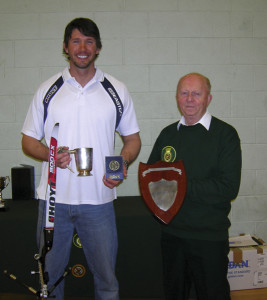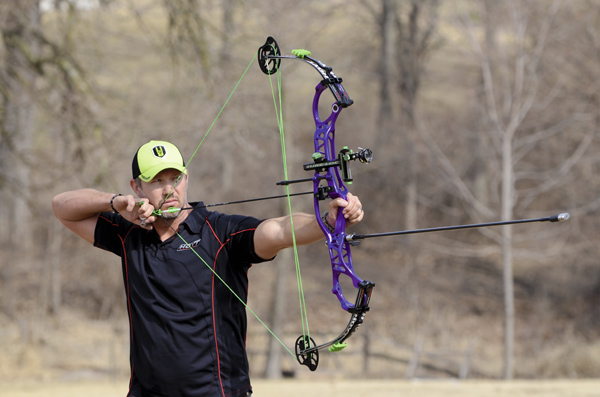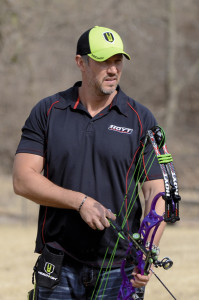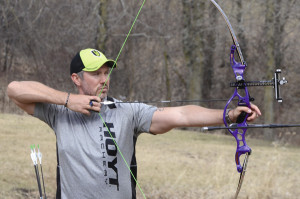A whole new perspective on archery is within your reach – John Dudley explains how to find it
I have been asked – by many archers and on many occasions – several common questions relating to performance archery. A few that come to mind are: “How can I perform at my best when everything is on the line?” or “what goes through your mind when you step to the line in a tournament?” and lastly, “how can I shoot as well on a tournament line as I do in my back yard?” Well friends, one thing that I learned many years ago in problem solving is to look for the common key words or common phrases. In the last three questions I just stated the one word that continually jumps out to me is the word “line”. It is a preconceived border or boundary to the game of archery. I totally understand the feelings, questions and emotions all relating to the ‘line’. Believe me when I say that – I have been there, done that, blew it plenty of times, and eventually figured out a way to buy the T-shirt.
What I would like to do in this article is share with you a very important rationality that eventually came to light for me. It completely changed my entire way of playing the archery game. This article will be unlike any of mine you have read because I am going to go a lot deeper than I have ever done before. It will be one that you need to read and think hard about. Then, right about the time you think you know what I’m saying, you will need to read it again and think even deeper. This will be an article that hopefully allows you to start looking at archery from a whole new place.
Where is the line?
Archery for me was always a challenge, not only for score and ranks, but also a personal challenge. Sure, I enjoyed the wins and, funnily enough, I enjoyed the many losses I had as well. Above all of that, I enjoyed something else that I don’t think many people out there really understand. I enjoyed seeking perfection in the sport. For years it was a game that continually beat me. In fact, my first tournament was so pathetic that I lost all my arrows before I could even finish. I started at the bottom and in last place. My competitive drive was fueled by defeat and I felt a real challenge and a real urgency to not let this sport beat me. Archery continually gave me new goals and something worth going after, but the thing I strived most for was perfection or completion. I wanted to have the same feeling as I had the first time I completed Super Mario Brothers. I wanted to know deep down that I knew all the moves to get to the end, and knew them well enough to do it again if I wanted to. I wanted to know I had totally completed it and that I knew what it took to win the game, not just beat the other player.
Like many others in archery, I spent a lot of time trying to perform on the line and score on the target. I saw archery as a world that had two points, a shooting line and a target at the end of it. It had an archer with arrows on one line, and together they scored on the target that was on another line. In tournaments, two people shared the same line and the same target. That was the game board and those were the boundaries. One day I was frustrated with my performance on the target and tired of my target panic. I felt like I had tried everything that I had been taught or read but still was far from perfect. I was not making improvements, and felt like I was just spinning my tyres. Out of desperation, I decided to try archery from a new angle. I started looking at what I was doing behind the line – instead of what was happening in front of it. I knew deep down that proper execution on a shot happens from pulling through the shot and making an unanticipated release. Unanticipated shots happen from “pulling through the shot”, “back tension”, the “relaxed shot” or whatever else you want to call it. The bottom line was it was happening in both the release hand and the rear back muscles. I realised that if I drew a line down myself from head to toe, that the shot execution actually happens in the back half of the body and not the front. Then the light bulb in my mind lit up – the back half is actually behind the line. It wasn’t about how still I could hold or how solidly I could aim. It was only about seeking a surprise, that happened behind the shooting line. I remember perfectly the first time I drew back, drew my attention away from the target, and felt this.
For me, in that exact moment, it felt like I completely understood archery and exactly what needed to happen to get it right. I want to make sure you don’t take that statement the wrong way because I am not saying that as a boast. I’m saying it as an important realisation of understanding what it takes to make a perfect shot. I have totally convinced myself that if you can focus “behind the line” then there is an immediate effect on what happens in front of it. The challenge in archery, for me, was perfecting the 10. Not the 10 on the target, but the 10 in execution. I had to look at myself from a different angle to be able to see everything that it took to make just one perfect shot. Once that happened, I then had the bar to strive for each and every time I drew back. The ‘secret’ for me was realising that the real 10s happen behind the shooting line, and not in front of it. If you can do what I am describing then believe me, everything else will take care of itself. In order to have the outcome that most people are striving for on the archery line, they need to know first where the line actually is. They may in fact need to look at themselves from a completely different perspective.
Where is your focus?
Another common question I am constantly asked is: “When aiming, do you focus on the target or on your sight pin?” I think you will be shocked to know that my focus is on neither. Relative to what I just told you, when I am aiming, my main focus is on the back half of my body and my motion. I don’t focus on my hold, and hardly at all on the target. Before engaging the trigger I get my pin on the target, and then let my subconscious do its best to centre my pin on the target. From there, I just go with the flow and let my front half move a little while I focus on my back half. I feel that, by eliminating the focus on the pin or on the target, I have ultimately eliminated two huge parts of the equation to target

The decision to learn to shoot a recurve was made in order to force John to focus on the mechanics, and not the medals
panic. Great golfers don’t focus on the hole, they focus on their swing. They look at the hole so they know where it is, but they know if the swing is right, then the ball goes to the right spot. I think most archers out there that are struggling with target panic and performance anxieties can completely change their outcome by bringing their attention back behind the line instead of the target or the sight pin. Forget about that stuff and forget about your finger on the trigger. Focus on the feel. Focus on the flow. Focus on every single muscle fibre that makes it happen.
To get one step closer to zen archery you need to open your mind and be okay with taking a loss on the competition field. Sometimes that is what it takes for you to be comfortable focusing on the shots instead of the scores. My belief is that panic and anxiety live forward of the shooting line. By not looking there it will be impossible to ever see them. By not focusing there you won’t ever find them. If you seek perfection in your shots, then focus your mind on this. You need to be able to close your eyes and visualise every part of your shot routine that sets you up perfectly at full draw. See all the parts of your shot, including the stance, your draw and the anchor. Then look at yourself from an outside perspective and see yourself going through the movements to perfectly flow through your shot execution. The subconscious is letting the pin float while the conscious is connecting the mind to your muscles. You need to feel everything about the pull until the release fires and the arrow leaves the bow. This needs to be something you strive to feel. You need to make this your bar to reach for, and nothing else. This feeling is graceful, it is smooth, it is perfect. I see now that the hardest shots to make in archery are the bad ones. Good shots are the easy ones. They require the least amount of work and much less energy. They just flow, they just happen. I am sure you have had the time where “it just went off” and somehow it was in the 10. It probably seemed too easy – but that was it.
I love archery and I find satisfaction knowing I can seek perfect archery anywhere that I have my bow and a target. I don’t compete at World Cups or World Championships any more, but it doesn’t matter. I don’t need that for myself. There doesn’t need to be anyone else there or anything on the line for me to get what I want out of archery. I realise now that archery is more than that. Despite what I first thought, completing archery was never about the medals or the records. The feeling of completion that I was looking for all this time was never down where my arrows hit the target. Completion was within reach of me this entire time. I was just looking in the wrong place. Complete it, it’s right there for you.





This is some of the best archery advice anyone can read! If you’re struggling with Target Panic or want to improve your scores, then this article will help lead you in the right direction!! Thanks John Dudley!!
Wow…..you confirmed something I am trying….allowing subconscious to aim while my conscious perfects the release….the only reason I thought of this is I have come to realize I have a hold…..the only thing that affects my hold is my release….or if I am not aligned properly.
very good article, I always tell newcomers ” if you do everything right, the result will be a ten”